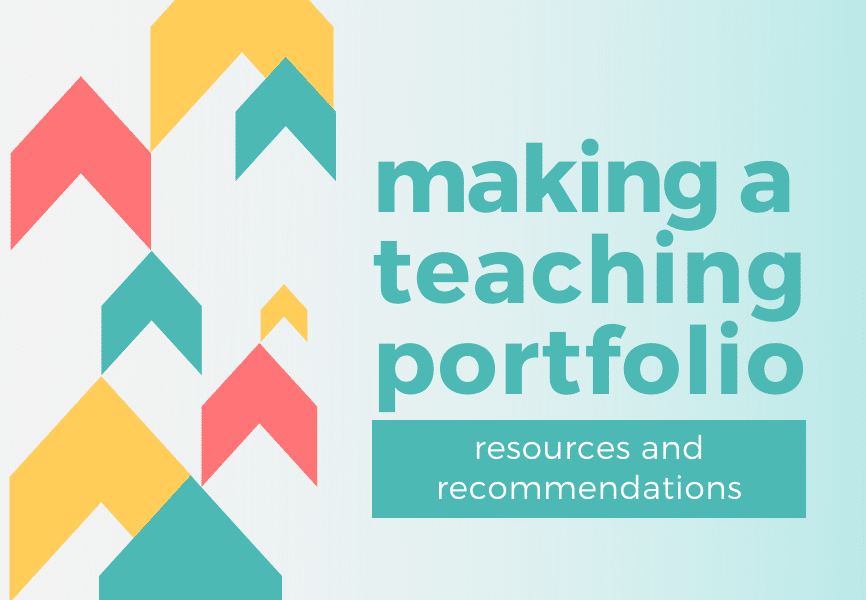With two main concentrations in the MA in WRD program, we wanted to provide students with portfolio resources for best leveraging their experiences and artifacts from each tract. This week, we will be sharing resources about teaching portfolios, and be sure to check in next week for information about portfolios for professional and digital writing.
Getting Started
“A teaching portfolio is a representation of your identity as a teacher. An effective portfolio conveys a coherent message about your beliefs and approaches to teaching and offers specific evidence to support that message.” —DePaul Teaching Commons | Teaching Portfolios
Creating a teaching portfolio allows you to articulate your identity as an educator and to showcase your pedagogical approach and materials.
First-Year Writing Director Erin Workman shared some of her advice about creating a teaching portfolio. While she struggled with design and conceptualizing her audience for various portfolios, Erin made many a portfolio during her graduate work at Florida State University. And, while she admits she was never satisfied with any of her final designs, she did find ways to make portfolio-creation work for her.
“A few things that helped: (1) extensive research on the kinds of jobs to which I was applying, (2) collecting and analyzing other professional portfolios to use as models, and (3) feedback from faculty mentors, colleagues who graduated and landed jobs like those I wanted, and peers in the program.”
Purpose
“A Teaching Portfolio is a useful tool that can help you:
- Develop, clarify, and reflect on your teaching philosophy, methods, and approaches
- Present teaching credentials for hiring and promotion in an academic position
- Document professional development in teaching
- Identify areas for improvement
- Prepare for the interview process” –Washington University | Teaching Portfolio
”Teaching portfolios can be particularly valuable for internship, job, and graduate school applications because they provide teachers with the opportunity to represent their teaching identities in a compelling and persuasive way. For these types of applications, teachers are often asked to submit a teaching philosophy and, when available, student course evaluations. Other typical documents include course syllabi, writing assignments, and responses to student work. Creating a teaching portfolio that includes these materials and organizes them in a way that better facilitates the reading process is more effective than simply submitting a collection of pdfs.”
Erin Workman
Potential Artifacts to Consider
So what might go in your final teaching portfolio? Below is a list of some deliverables from classes that you might consider including in your professional portfolio.
- Teaching Philosophy (WRD 540 – Teaching Writing)
- Assignment Sheet (WRD 540 – Teaching Writing)
- Lesson Plans (WRD 543 – Teaching ESL Writing; WRD 544 – Teaching English as a Second or Foreign Language)
- Community Literacy Project (WRD 542 – Urban Literacies)
- Online Course Module (WRD 545 – Teaching Writing Online)
- Syllabus (WRD 551 – Teaching Apprenticeship Practicum)
- Course Materials: assignment sheets, PowerPoints, lesson plans (WRD 551 – Teaching Apprenticeship Practicum)
- Student Evaluation Summaries (WRD 551 – Teaching Apprenticeship Practicum)
- Student Work Samples, with permission (WRD 551 – Teaching Apprenticeship Practicum)
- Tutoring Philosophy (WRD 582 – Writing Center Theory and Pedagogy)
- Blog Posts (WRD GA or UCWbL)
- Research Projects, Publications, Conference Presentations
- Resume / CV
Teaching Portfolio Examples
Kristen Biven’s Portfolio
Dr. Kristen Bivens teaches writing at Harold Washington College and was the Winter Quarter’s invited guest for the WRD Speaker Series “Writing Across Borders.” During her workshop and presentation, she shared her personal portfolio / website with us, and with its clean and easy to navigate menu and layout, this portfolio can help you think about how you organize your materials.
Paul Gordon Brown’s Portfolio
Dr. Brown is a “speaker, author, and educator specializing in digital student learning and residential curriculum in higher education.” What is so cool about this portfolio is the way in which every page contributes to his identity as an educator and the ways that his values are clearly displayed in each sample and artifact. While the navigational menu is a bit heavy and includes almost too many options, the content of each page is a good example of how to create flows of information and use hyperlinks as a way to connect viewers to other pages.
Erin Workman’s Professional Portfolio
DePaul FYW Director Dr. Erin Workman’s professional portfolio highlights her varied educational roles as an instructor and administrator, while showing the very human side to both. Through the use of slideshows and photos, Erin’s portfolio shows the audience who she is and how she is in the classroom. Scrolling through her teaching tab, readers can see real photos of her students and even the notes she takes on the board, giving us a clear sense of what her classroom is like.
General Resources
- DePaul Teaching Commons | Teaching Portfolios
- CCCC | CCCC Position Statement on Principles and Practices in Electronic Portfolios
- Auburn University | The Auburn ePortfolio Project
- Vanderbilt Center for Teaching | Components of a Teaching Portfolio
- Washington University in St. Louis Center for Teaching and Learning | What is a Teaching Portfolio
- University of Virginia Center for Teaching Excellence | Teaching Portfolios and How They are Used

Comments are closed.